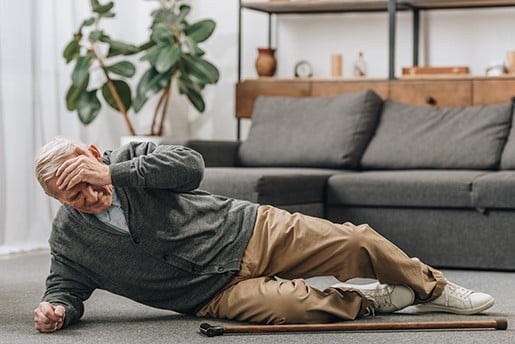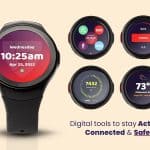
You probably have some general idea of what a fall detection device does. After all, most of you probably remember the “I’ve fallen, and I can’t get up” commercials on TV. Today we would like to teach you what fall detection technology looks like now — more than 30 years after those commercials first aired. We will tell you how to shop for a fall detection device as well as help you determine if you may benefit from this technology in your life. In addition, you can read our Lifeline reviews for the latest offering in the market.
What is Fall Detection?
Fall detection is much more sophisticated than the button shown on commercials in the late 1980’s. In fact, those commercials featured medical assistance buttons, rather than fall detectors.
Fall detection is just one feature of some medical alert devices. Fall detectors have an accelerometer, which is a low-powered radio wave that senses movement. Fall detectors are programmed to determine whether a movement was a result of an every-day activity or whether a movement was a result of a fall.
Fall detectors look for quick changes in body positioning. If the device determines that the person’s body position and physical activity may indicate that a fall took place, the appropriate authorities are alerted. Fall detectors do not work 100% of the time, especially when the fall was more of a result of a slide rather than an abrupt movement.
It is essential to realize that not every medical alert device includes fall detection. In fact, most medical alert systems charge an extra fee for fall detection services. You could save money and simply purchase a device that requires the individual to push a button to ask for help. While this type of device might work in most scenarios, it would not be helpful for someone who fell and was unable to push a button as a result of unconsciousness or some other medical emergency.
Fall detectors can speed up response times. Even if a person is conscious after a fall, he or she may sometimes hesitate before deciding to press a button for help. The person may not realize that the fall was a result of a medical emergency, and the individual may not want to “be a bother” and ask for help. But when a user is wearing a device with a fall detector system, the person is more likely to receive the help that he or she needs.
How do you Pick a Fall Detection Service?
There are many different features to look for when purchasing a medical alert device with fall detection.
First, the device should be lightweight and comfortable to wear. People are less likely to wear a large, clunky device. If the user doesn’t wear the device, what’s the point in having one? And it needs to be comfortable enough to wear at all times. After all, no one can determine when a fall is going to take place.
Second, consider looking for a waterproof device. The Center for Disease Control report titled “Nonfatal Bathroom Injuries Among Persons Aged ≥15 Years” says that 80% of all bathroom injuries were caused by falls, with the highest injury rates in the oldest age group. It would make sense that many of these injuries resulted from slipping in the bath or shower. This means that your medical alert device should be waterproof.
Next, when choosing a system, make sure it works for your situation. Some medical alert systems work only through land-line phones, while others may work through cell phone service. If you live in an area with unreliable cell coverage, you may want to make sure that the signal is strong enough before you commit to a particular service.
Also, one should read the reviews of fall detection services before choosing the one that is right for you. See which companies offer the best customer support and those that stand behind their service with money-back guarantees.
Finally, compare the response times for each type of fall-detection service. Find out who will be monitoring the system as well as how quickly they respond to alerts.
Who should wear a Fall Detector?
According to “Fall Detection Devices and their Use with Older Adults: A Systematic Review,” adults 65 years or older are at a higher risk for falls. The report states that one in every three people over the age of 65 falls at least once a year. These falls can have disastrous consequences.
While this report does not mean that every person aged 65 years and older should wear a fall detection device, it does say that age is just one of the factors to consider when making that decision.
Although there is not a government-issued list of criteria advising when to wear a fall detection device, common sense says that they could provide reassurance and comfort in the following scenarios:
- Consider wearing a fall detection device if you have diabetes or have another medical condition that causes your blood sugar to fluctuate.
- Those who are susceptible to heart attacks or strokes may consider wearing a fall detector, especially since those suffering a stroke may be unable to push a button for help.
- Those with balance or mobility issues should consider wearing a fall detector in their daily lives.
- Older adults who live alone might feel more at ease, knowing that a fall detector would alert authorities in case of an emergency.
It is worth noting that there are things that you can do to reduce your risk of falling. Make sure you visit your doctor regularly and monitor your blood sugar and blood pressure. Make sure the medications that you take are the right ones for you. Visit your eye doctor regularly to make sure your vision remains sharp.
Consider engaging in exercise to improve your balance and strength, such as yoga or Pilates, but check with your doctor first before starting any new exercise routine.
Make sure your home is safe. Remove items off the floor that may cause you to trip. Tripping hazards may include throw rugs, wires or cables, and items placed near steps.
As you can see, fall detection devices have come a long way since the late 1980’s. Do your research to pick the best device for your situation.
Featured image Credit: Andrew Lozovyi / Deposit Photos


